War Propaganda About Ukraine Becoming More Militaristic, Authoritarian, and Reckless
War Propaganda About Ukraine Becoming More Militaristic, Authoritarian, and Reckless
Every useful or pleasing claim about the war, no matter how unverified or subsequently debunked, rapidly spreads, while dissenters are vilified as traitors or Kremlin agents.
Less than a week into this war, that can no longer be said. One of the media's most beloved members of Congress, Rep. Adam Kinzinger (R-IL), on Friday explicitly and emphatically urged that the U.S. military be deployed to Ukraine to establish a “no-fly zone” — i.e., American soldiers would order Russia not to enter Ukrainian airspace and would directly attack any Russian jets or other military units which disobeyed. That would, by definition and design, immediately ensure that the two countries with by far the planet's largest nuclear stockpiles would be fighting one another, all over Ukraine.
Kinzinger's fantasy that Russia would instantly obey U.S. orders due to rational calculations is directly at odds with all the prevailing narratives about Putin having now become an irrational madman who has taken leave of his senses — not just metaphorically but medically — and is prepared to risk everything for conquest and legacy. This was not the first time such a deranged proposal has been raised; days before Kinzinger unveiled his plan, a reporter asked Pentagon spokesman John Kirby why Biden has thus far refused this confrontational posture. The Brookings Institution's Ben Wittes on Sunday demanded: “Regime change: Russia.” The President of the Council on Foreign Relations, Richard Haass, celebrated that “now the conversation has shifted to include the possibility of desired regime change in Russia.”
Having the U.S. risk global nuclear annihilation over Ukraine is an indescribably insane view, as one realizes upon a few seconds of sober reflection. We had a reminder of that Sunday morning when “Putin ordered his nuclear forces on high alert, reminding the world he has the power to use weapons of mass destruction, after complaining about the West’s response to his invasion of Ukraine” — but it is completely unsurprising that it is already being suggested.
There is a reason I devoted the first fifteen minutes of my live video broadcast on Thursday about Ukraine not to the history that led us here and the substance of the conflict (I discussed that in the second half), but instead to the climate that arises whenever a new war erupts, instantly creating propaganda-driven, dissent-free consensus. There is no propaganda as potent or powerful as war propaganda. It seems that one must have lived through it at least once, as an engaged adult, to understand how it functions, how it manipulates and distorts, and how one can resist being consumed by it.
As I examined in the first part of that video discussion, war propaganda stimulates the most powerful aspects of our psyche, our subconscious, our instinctive drives. It causes us, by design, to abandon reason. It provokes a surge in tribalism, jingoism, moral righteousness and emotionalism: all powerful drives embedded through millennia of evolution. The more unity that emerges in support of an overarching moral narrative, the more difficult it becomes for anyone to critically evaluate it. The more closed the propaganda system is — either because any dissent from it is excluded by brute censorship or so effectively demonized through accusations of treason and disloyalty — the more difficult it is for anyone, all of us, even to recognize one is in the middle of it.
When critical faculties are deliberately turned off based on a belief that absolute moral certainty has been attained, the parts of our brain armed with the capacity of reason are disabled. That is why the leading anti-Russia hawks such as former Obama Ambassador Michael McFaul and others are demanding that no “Putin propagandists” (meaning anyone who diverges from his views of the conflict) even be permitted a platform, and why many are angry that Facebook has not gone far enough by banning many Russian media outlets from advertising or being monetized. Sen. Mark Warner (D-VA), using the now-standard tactic of government officials dictating to social media companies which content they should and should not allow, announced on Saturday: “I'm concerned about Russian disinformation spreading online, so today I wrote to the CEOs of major tech companies to ask them to restrict the spread of Russian propaganda.” Suppressing any divergent views or at least conditioning the population to ignore them as treasonous is how propagandistic systems remain strong.
It is genuinely hard to overstate how overwhelming the unity and consensus in U.S. political and media circles is. It is as close to a unanimous and dissent-free discourse as anything in memory, certainly since the days following 9/11. Marco Rubio sounds exactly like Bernie Sanders, and Lindsay Graham has no even minimal divergence from Nancy Pelosi. Every word broadcast on CNN or printed in The New York Times about the conflict perfectly aligns with the CIA and Pentagon's messaging. And U.S. public opinion has consequently undergone a radical and rapid change; while recent polling had shown large majorities of Americans opposed to any major U.S. role in Ukraine, a new Gallup poll released on Friday found that “52% of Americans see the conflict between Russia and Ukraine as a critical threat to U.S. vital interests” with almost no partisan division (56% of Republicans and 61% of Democrats), while “85% of Americans now view [Russia] unfavorably while 15% have a positive opinion of it.”
The purpose of these points, and indeed of this article, is not to persuade anyone that they have formed moral, geopolitical and strategic views about Russia and Ukraine that are inaccurate. It is, instead, to highlight what a radically closed and homogenized information system most Americans are consuming. No matter how convinced one is of the righteousness of one's views on any topic, there should still be a wariness about how easily that righteousness can be exploited to ensure that no dissent is considered or even heard, an awareness of how often such overwhelming societal consensus is manipulated to lead one to believe untrue claims and embrace horribly misguided responses.
To believe that this is a conflict of pure Good versus pure Evil, that Putin bears all blame for the conflict and the U.S., the West, and Ukraine bear none, and that the only way to understand this conflict is through the prism of war criminality and aggression only takes one so far. Such beliefs have limited utility in deciding optimal U.S. behavior and sorting truth from fiction even if they are entirely correct — just as the belief that 9/11 was a moral atrocity and Saddam (or Gaddafi or Assad) was a barbaric tyrant only took one so far. Even with those moral convictions firmly in place, there are still a wide range of vital geopolitical and factual questions that must be considered and freely debated, including:
The severe dangers of unintended escalation with greater U.S. involvement and confrontation toward Russia;
The mammoth instability and risks that would be created by collapsing the Russian economy and/or forcing Putin from power, leaving the world's largest or second-largest nuclear stockpile to a very uncertain fate;
The ongoing validity of Obama's long-standing view of Ukraine (echoed by Trump), which persisted even after Moscow annexed Crimea in 2014 following a referendum, that Ukraine is of vital interest only to Russia and not the U.S., and the U.S. should never risk war with Russia over it;
The bizarre way in which it has become completely taboo and laughable to suggest that NATO expansion to the Russian border and threats to offer Ukraine membership is deeply and genuinely threatening not just to Putin but all Russians, even though that warning has emanated for years from top U.S. officials such as Biden's current CIA Director William Burns as well as scholars across the political spectrum, including the right-wing realist John Mearsheimer and the leftist Noam Chomsky.
The clearly valid questions regarding actual U.S intentions concerning Ukraine: i.e., that a noble, selfless and benevolent American desire to protect a fledgling democracy against a despotic aggressor may not be the predominant goal. Perhaps it is instead to revitalize support for American imperialism and intervention, as well as faith in and gratitude for the U.S. security and military state (the Eurasia Group's Ian Bremmer suggested this week that this is the principal outcome in the West of the current conflict). Or the goal may be the re-elevation of Russia as a vital and grave threat to the U.S. (the above polling data suggests this is already happening) that will feed weapons purchases and defense and intelligence budgets for years to come. Or one might see a desire to harm Russia, as vengeance for the perception that Putin helped defeat Hillary Clinton and elected Donald Trump (that the U.S. is using Ukraine to “fight Russia over there” was explicitly stated by Rep. Adam Schiff (D-CA)).
Or perhaps the goal is not to “save and protect” Ukraine at all, but to sacrifice it by turning that country into a new Afghanistan, where the U.S. arms a Ukrainian insurgency to ensure that Russia remains stuck in Ukraine fighting and destroying it for years (this scenario was very compellingly laid out in one of the best analyses of the Russia/Ukraine conflict, by Niccolo Soldo, which I cannot recommend highly enough).
Jeff Rogg, historian of U.S. intelligence and an assistant professor in the Department of Intelligence and Security Studies at the Citadel, wrote in The LA Times this week that the CIA has already been training, funding and arming a Ukrainian insurgency, speculating that the model may be the CIA's backing of the Mujahideen insurgency in Afghanistan that morphed into Al Qaeda, with the goal being “to weaken Russia over the course of a long insurgency that will undoubtedly cost as many Ukrainian lives as Russian lives, if not more."
Again, no matter how certain one is about their moral conclusions about this war, these are urgent questions that are not resolved or even necessarily informed by the moral and emotional investment in a particular narrative. Yet when one is trapped inside a system of a complete consensus upheld by a ceaseless wave of reinforcing propaganda, and when any questioning or dissent at all is tantamount to treason or “siding with the enemy,” there is no space for such discussions to occur, especially within our minds. When one is coerced — through emotional tactics and societal inventive — to adhere only to one script, nothing that is outside of that script can be entertained. And that is all by design.
Besides 9/11 and the lead-up to the invasion of Iraq, Americans have been subjected to numerous spates of war propaganda, including in 2011 when then-President Obama finally agreed to order the U.S. to participate in a France/UK-led NATO regime change operation in Libya, as well as throughout the Obama and early Trump years when the CIA was fighting a clandestine and ultimately failed regime change war in Syria, on the same side as Al-Qaeda, to overthrow Bashar al-Assad. In both instances, government/media disinformation and emotional manipulation were pervasive, as it is in every war. But those episodes were not even in the same universe of intensity and ubiquity as what is happening now and what happened after 9/11 — and that matters a great deal for understanding why so many are vulnerable to the machinations of war propaganda without even realizing they are affected by it.
One realization I had for the first time during Russiagate was that history may endlessly repeat itself, but those who have not lived through any such history or paid attention to it previously will not know about it and thus remain most susceptible to revisionism or other tactics of deceit. When Russiagate was first unveiled as a major 2016 campaign theme — through a Clinton campaign commercial filled with dark and sinister music and innuendo masquerading as “questions” about the relationship between Trump and the Kremlin — I had assumed when writing about it for the first time that most Americans, especially those on the left taught to believe that McCarthyism was one of the darkest moments for civil liberties, would instantly understand how aggressively the CIA and FBI disseminate disinformation, how servile corporate media outlets are to those security state agencies, how neocons are always found at the center of such manipulative tactics, and how potent this sort of propaganda is. The common theme is creating a foreign villain said to be of unparalleled evil or at least evil not seen since Hitler, then accusing one's political adversaries of being enthralled by or captive to them. We have witnessed countless identical cycles throughout U.S history.
But I also quickly realized that millions of Americans — either due to age or previous political indifference — began paying attention to politics for the first time in 2016 due to fear of Trump, and thus knew little to nothing about anything that preceded it. Such people had no defenses against the propaganda narrative and deceitful tactics because, for them, it was all new. They had never experienced it before and thus had no concept of who they were applauding and how such official government/media disinformation campaigns are constructed. Each generation is thus easily programmed and exploited by the same propaganda systems, no matter how discredited they were previously.
Although such episodes are common, one has to travel back to the period of 2001-03, following the 9/11 attack on U.S. soil, and through the invasion of Iraq, in order to find an event that competes with the current moment in terms of emotional intensity and lockstep messaging throughout the West. Comparing that historical episode to now is striking, because the narrative themes deployed then are identical to those now; the very same people who led the construction of that narrative and accompanying rhetorical tactics are the ones playing a similar role now; and the reaction that these themes trigger are virtually indistinguishable.
Many who lived through the enduring trauma and mass rage of 9/11 as an adult need no reminder of what it was like and what it consisted of. But millions of Americans now focused on Ukraine did not live through that. And for many who did, they have, with the passage of two decades, revised or now misremember many of the important details of what took place. It is thus worthwhile to recall the broad strokes of what we were conditioned to believe to see how closely it tracks the consensus framework now.
Both the 9/11 attack and the invasion of Iraq were cast as clear Manichean battles: one of absolute Good fighting absolute Evil. That framework was largely justified through its companion prism: the subsequent War on Terror and specific wars (in Iraq and Afghanistan) represented the forces of freedom and democracy (the U.S. and its allies) defending itself against despotism and mad, primitive barbarism. We were attacked not because of decades of intervention and aggression in their part of the world but because they hated us for our freedom. That was all one needed to know: it was a war between enlightened democrats and psychotic savages.
As a result, no nuance was permitted. How can there be room for nuance or even questioning when such clear moral lines emerge? A binary framework was thus imposed: “Either you are with us or you are with the terrorists,” decreed President George W. Bush in his speech to the Joint Session of Congress on September 20, 2001. Anyone questioning or disputing any part of the narrative or any of the U.S. policies championed in its name stood automatically accused of treason or being on the side of The Terrorists. David Frum, fresh off his job as a White House speechwriter penning Bush's war speeches, in which Bush proclaimed the U.S. was facing an “Axis of Evil,” published a 2003 article in National Review about right-wing opponents of the invasion of Iraq, aptly titled: “Unpatriotic Conservatives.” Go look how cheaply and easily people were accused of being on the side of The Terrorists or traitors for the slightest deviation from the dominant narrative.
Like all effective propaganda, the consensus assertions about 9/11 and Iraq had a touchstone to the truth. Indeed, some of the fundamental moral claims were true. The civilian-targeting 9/11 attack was a moral atrocity, and the Taliban and Saddam really were barbaric despots (including when the U.S. had previously supported and funded them). But those moral claims only took one so far: specifically, they did not take one very far at all. Many who enthusiastically embraced those moral propositions ended up also embracing numerous falsehoods emanating from the U.S. Government and loyal media outlets, as well as supporting countless responses that were both morally unjustified and strategically unwise. Polls at the start of the Iraq War showed large majorities in favor of and believing outright falsehoods (such as that Saddam helped personally plan the 9/11 attack), while polls years later revealed a “huge majority” which now views the invasion as a mistake. Similarly, it is now commonplace to hear once-unquestioned policies — from mass NSA spying, to lawless detention, to empowering the CIA to torture, to placing blind faith in claims from intelligence agencies — be declared major mistakes by those who most vocally cheerlead those positions in the early years of the War on Terror.
In other words, correctly apprehending key moral dimensions to the conflict provided no immunity against being propagandized and misled. If anything, the contrary was true: it was precisely that moral zeal that enabled so many people to get so carried away, to be so vulnerable to having their (often-valid) emotions of rage and moral revulsion misdirected into believing falsehoods and cheering for moral atrocities in the name of vengeance or righteous justice. That moral righteousness crowded out the capacity to reason and think critically and unified huge numbers of Americans into herd behavior and group-think that led them to many conclusions which, two decades later, they recognize as wrong.
It should not be difficult, even for those who did not live through those events but who can now look back at what happened, to see the overwhelming similarities between then and now. The role of bin Laden and Saddam — as unhinged, mentally unwell, unrepentant mass murderers and despots, the personification of pure evil — is now occupied by Putin. “Putin is evil. Every American watching what’s happening in Ukraine should know that,” instructed Rep. Liz Cheney (R-WY), daughter of the author of the virtually identical 9/11 and Iraq morality scripts. Conversely, the U.S. and its allies are the blame-free, morally upright spreaders of freedom, defenders of democracy and faithfully adhering to a rules-based international order.
This exact framework remains in place; only the parties have changed. Now, anyone questioning this narrative in whole or in part, or disputing any of the factual claims being made by the West, or questioning the wisdom or justice of the role the U.S. is playing, is instantly deemed not “on the side of the terrorists" but "on the side of Russia”: either for corrupt monetary reasons or long-hidden and hard-to-explain ideological sympathy for the Kremlin. “There is no excuse for praising or appeasing Putin,” announced Rep. Cheney, by which — like her father before her and McFaul now — she means anyone deviating in any way from the full panoply of U.S. assertions and responses. Wyoming's vintage neocon also instantly applied this accusatory treason matrix to former President Trump, arguing that he “aids our enemies” and his “interests don’t seem to align with the interests of the United States of America."
Everyone watching this week-long mauling of dissenters understood the messaging and incentives: either get on board or stay silent lest you be similarly vilified. And that, in turn, meant there were fewer and fewer people willing to publicly question prevailing narratives, which made it in turn far more difficult for anyone else to separate themselves from unified group-think.
One instrument of propaganda that did not exist in 2003 but most certainly does now is social media, and it is hard to overstate how much it is exacerbating all of these pathologies of propaganda. The endless flood of morally righteous messaging, the hunting down of and subsequent mass-attacks on heretics, the barrage of pleasing-but-false stories of bravery and treachery, leave one close to helpless to sort truth from fiction, emotionally manipulative fairy tales from critically scrutinized confirmation. It is hardly novel to observe that social media fosters group-think and in-group dynamics more than virtually any other prior innovation, and it is unsurprising that it has intensified all of these processes.
Another new factor separating the aftermath of 9/11 from the current moment is Russiagate. Starting in mid-2016, the Washington political and media class was obsessed with convincing Americans to view Russia as a grave threat to them and their lives. They created a climate in Washington in which any attempts to forge better relations with the Kremlin or even to open dialogue with Russian diplomats and even just ordinary Russian nationals was depicted as inherently suspect if not criminal. All of that primed American political culture to burst with contempt and rage toward Russia, and once they invaded Ukraine, virtually no effort was needed to direct that long-brewing hostility into an uncontrolled quest for vengeance and destruction.
That is why it is anything but surprising that incredibly dangerous proposals like the one by Rep. Kizinger for deployment of the U.S. military to Ukraine have emerged so quickly. This orgy in high dudgeon of war propaganda, moral righteousness, and a constant flow of disinformation produces a form of collective hysteria and moral panic. In his 1931 novel Brave New World, Aldous Huxley perfectly described what happens to humans and our reasoning process when we are subsumed by crowd sentiments and dynamics:
Groups are capable of being as moral and intelligent as the individuals who form them; a crowd is chaotic, has no purpose of its own and is capable of anything except intelligent action and realistic thinking. Assembled in a crowd, people lose their powers of reasoning and their capacity for moral choice. Their suggestibility is increased to the point where they cease to have any judgment or will of their own. They become very excitable, they lose all sense of individual or collective responsibility, they are subject to sudden accesses of rage, enthusiasm and panic. In a word, a man in a crowd behaves as though he had swallowed a large dose of some powerful intoxicant. He is a victim of what I have called "herd-poisoning." Like alcohol, herd-poison is an active, extraverted drug. The crowd-intoxicated individual escapes from responsibility, intelligence and morality into a kind of frantic, animal mindlessness.
We have seen similar outbreaks many times over the last couple of decades, but nothing produces it more assuredly than war sentiments and the tribal loyalties that accompany them. And nothing exacerbates it like the day-long doom scrolling through Twitter, Facebook and Instagram which so much of the world is currently doing. Social media platforms, by design, enable one to block out all unpleasant information or dissident voices and only feed off content and claims that validate what they wish to believe.
Kinzinger's call for a US-imposed no-fly zone is far from the only unhinged assertion or claim spewing forth from the U.S. opinion-shaping class. We are also witnessing a radical increase in familiar authoritarian proposals coming from U.S. politicians. Two other members of Congress who are most beloved by the media, Rep. Eric Swalwell (D-CA) and Rep. Ruben Gallego (D-AZ), suggested that all Russians should be immediately deported from the U.S., including Russian students studying at American universities. The rationale is similar to the one that drove FDR's notorious World War II internment of all people of Japanese descent — citizens or immigrants — in camps: namely, in times of war, all people who come from the villain or enemy country deserve punishment or should be regarded as suspect. A Washington Post columnist, Henry Olsen, proposed banning all Russia athletes from entering the U.S.: “No Russian NHL, football, or tennis players so long as the war and claims on Ukrainian territory exist.”
Sen. Mike Lee (R-UT), long a vocal advocate of requiring congressional approval for the deployment by the president of military forces to war zones, argued on Friday that Biden's troop movements to Eastern Europe constitute war decisions that constitutionally necessitate Congressional approval. “President Biden’s unilateral deployment of our Armed Forces to the European theater, where we now know they are in imminent hostilities, triggers the War Powers Act, necessitating that the President report to Congress within 48 hours,” he said. Sen. Lee added: “The Constitution requires that Congress must vote to authorize any use of our Armed Forces in conflict.”
For this simple and basic invocation of Constitutional principles, Lee was widely vilified as a traitor and Russian agent. “Are you running for Senator of Moscow? Because that’s where you belong,” one Democratic Congressional candidate, the self-declared socialist and leftist Joey Palimeno (D-GA), rhetorically asked. Now-perennial independent candidate Evan McMullin, formerly a CIA operative in Syria, dubbed Lee “Moscow Mike” for having raised this constitutional point, claiming he did so not out of conviction but “to distract from the fact that he traveled to Russia and brazenly appeased Vladimir Putin for his own political gain.”
Other than calling Lee a paid Russian agent and traitor, the primary response was the invocation of Bush/Cheney's broad Article II executive power theories to insist that the president has the unfettered right to order troop deployments except to an active war zone — as if the possibility of engaging Russian forces was not a primary motive for these deployments. Indeed, the Pentagon itself said the troop deployments were to ensure the troops “will be ready if called upon to participate in the NATO Response Force” and that “some of those U.S. personnel may also be called upon to participate in any unilateral actions the U.S. may undertake." Even if one disagrees with Lee's broad view of the War Powers Act and the need for Congress to approve any decisions by the president that may embroil the country in a dangerous war, that Lee is a Kremlin agent and a traitor to his country merely for advocating a role for Congress in these highly consequential decisions reflects how intolerant and dissent-prohibiting the climate has already become.
Disinformation and utter hoaxes are now being aggressively spread as well. Both Rep. Kinzinger and Rep. Swalwell ratified and spread the story of the so-called "Ghost of Kyiv,” a Ukrainian fighter pilot said to have single-handedly shot down six Russian planes. Tales and memes commemorating his heroism viralized on social media, ultimately ratified by these members of Congress and other prominent voices. The problem? It is a complete hoax and scam, concocted through a combination of deep fake videos based on images from a popular video game. Yet to date, few who have spread this fraud have retracted it, while censorship-happy Big Tech corporations have permitted most of these fraudulent posts to remain without a disinformation label on it. We are absolutely at the point — even as demands escalate for systematic censorship by Big Tech of any so-called “pro-Russian” voices — where disinformation and fake news are considered noble provided they advance a pro-Ukrainian narrative.
Western media outlets have also fully embraced their role as war propagandists. They affirm any story provided it advances pro-Ukrainian propaganda without having the slightest idea whether it is true. A charming and inspiring story about a small group of Ukrainian soldiers guarding an installation in a Black Sea island went wildly viral on Saturday and ultimately was affirmed as truth by multiple major Western news outlets. A Russian warship demanded they surrender and, instead, they responded by replying: “fuck you, Russian warship,” their heroic last words before dying while fighting. Ukraine said “it will posthumously honor a group of Ukrainian border guards who were killed defending a tiny island in the Black Sea during a multi-pronged Russian invasion.” Yet there is no evidence at all that they died; the Russian government claims they surrendered, and the Ukrainian military subsequently acknowledged the same possibility.
Obviously, neither the Russian nor Ukrainian versions should be accepted as true without evidence, but the original, pleasing Ukrainian version should not either. The same is true of:
the equally inspiring story that the Ukrainian military shot down two Russian Il-76s transport plains (no evidence);
a Russian tank purposely and randomly ran over a civilian car (the video suggests a possible accident and, more importantly, subsequent news accounts acknowledged: “it wasn’t immediately clear if the armored vehicle was Russian or Ukrainian hardware, or when this crash took place”);
a mega-viral thread from a member of the EU Parliament claiming Russian oligarchs and Putin were screaming at each other in a bunker in desperation (pronounced “likely disinfo” by the US-intel-friendly and vehemently anti-Russia site Bellingcat);
a gratifying story that Turkey told Ukraine that it informed Russia it was barred from using Turkish straits to enter the Black Sea (Turkey denied telling this to President Zelensky and said they could not and would not do that, then on Sunday said they had determined these events constitute a “war” such that they may have the power them to ban both Ukraine and Russia, but had not yet decided to so);
a thrilling photo of Zelensky in body armor on the front lines against Russia (it was from months ago), and,
claims that Russia targeted a civilian apartment building with a missile (it appears at least possible that the missile was a misguided Ukrainian air defense weapon).
But we are way past the point where anyone cares about what is or is not factually true, including corporate outlets. Any war propaganda — videos, photos, unverified social media posts — that is designed to tug on Western heartstrings for Ukrainians or appear to cast them as brave and noble resistance fighters, or Russians as barbaric but failing mass murderers, gets mindlessly spread all over without the slightest concern for whether it is true. To be on social media or to read coverage from Western news outlets is to place yourself into a relentless vortex of single-minded, dissent-free war propaganda. Indeed, some of the above-referenced stories may turn out to be true, but spreading them before there is any evidence of them is beyond reckless, especially for media outlets whose role is supposed to be the opposite of propagandists.
None of this means the views you may have formed about the war in Ukraine are right or wrong. It is of course possible that the Western consensus is the overwhelmingly accurate one and that the moral framework that has been embraced is the correct prism for understanding this conflict. All sides in war wield propaganda, and that certainly includes the Russians and their allies as well. This article is not intended to urge the adoption of one viewpoint or the other.
It is, instead, intended to urge the recognition of what the effects of being immersed in one-sided, intense and highly emotionalized war propaganda are — effects on your thinking, your reasoning, your willingness to endorse claims or support policies, your comfort with having dissent either banished or inherently legitimized. Precisely because this propaganda has been cultivated over centuries to so powerfully and adeptly manipulate our most visceral reactions, it is something to be resisted even if — perhaps especially if — it is coming from the side or viewpoint you support.


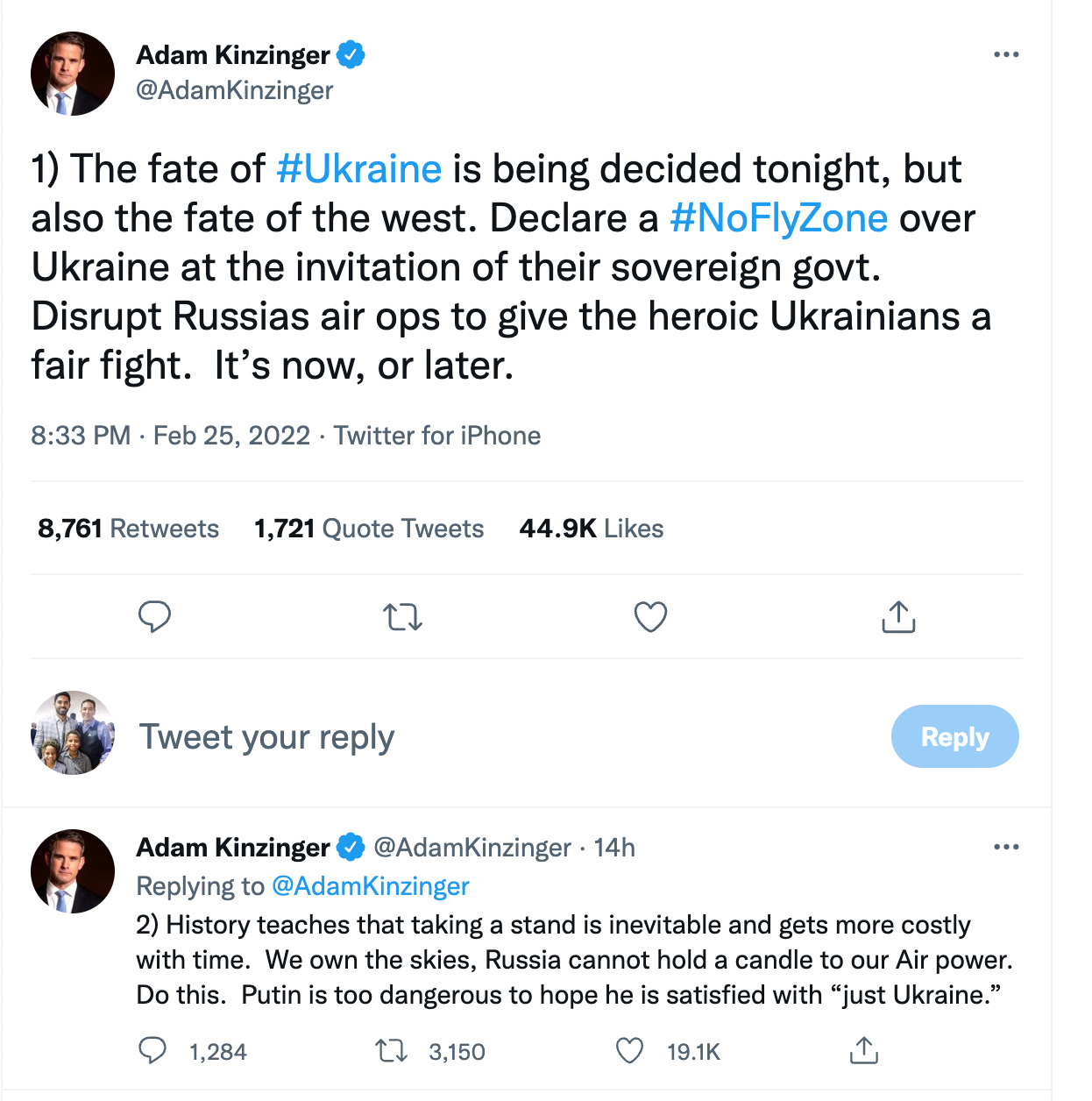
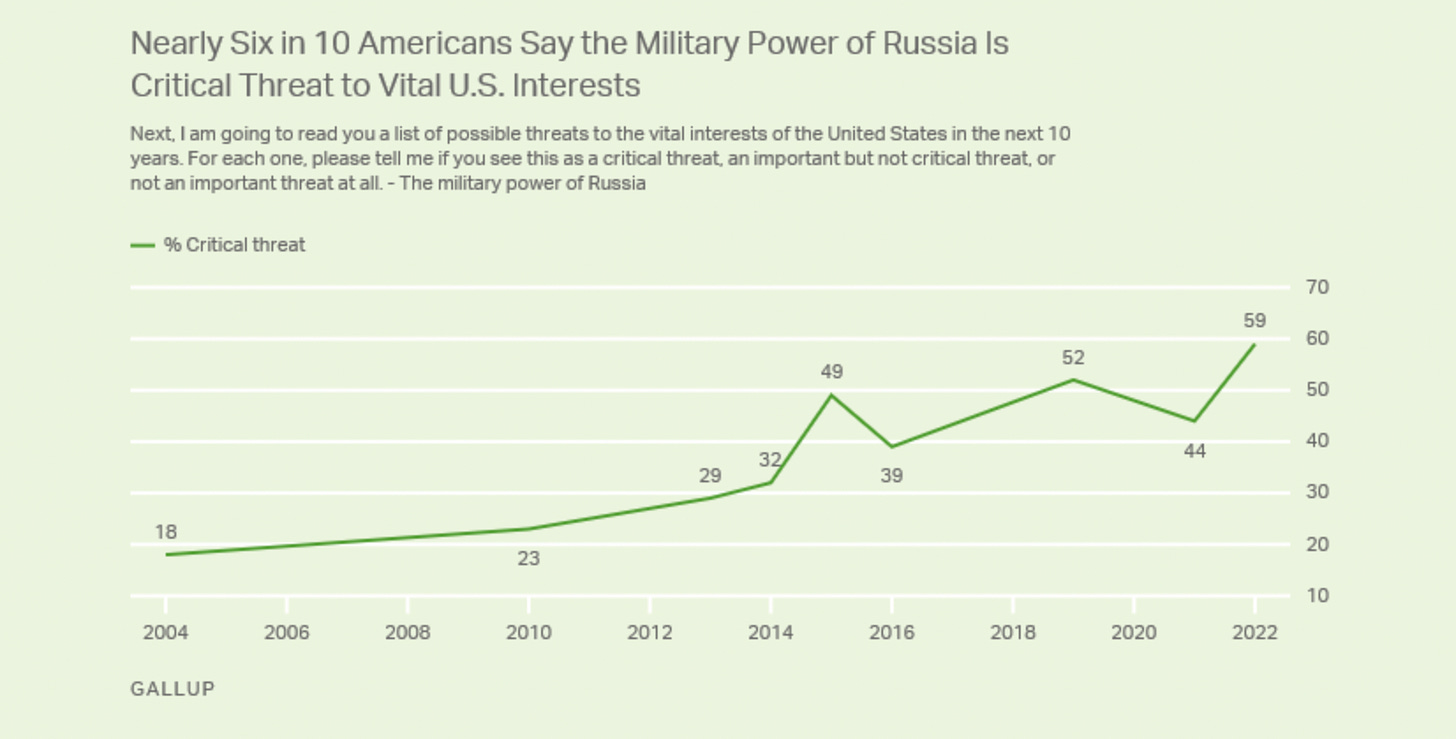
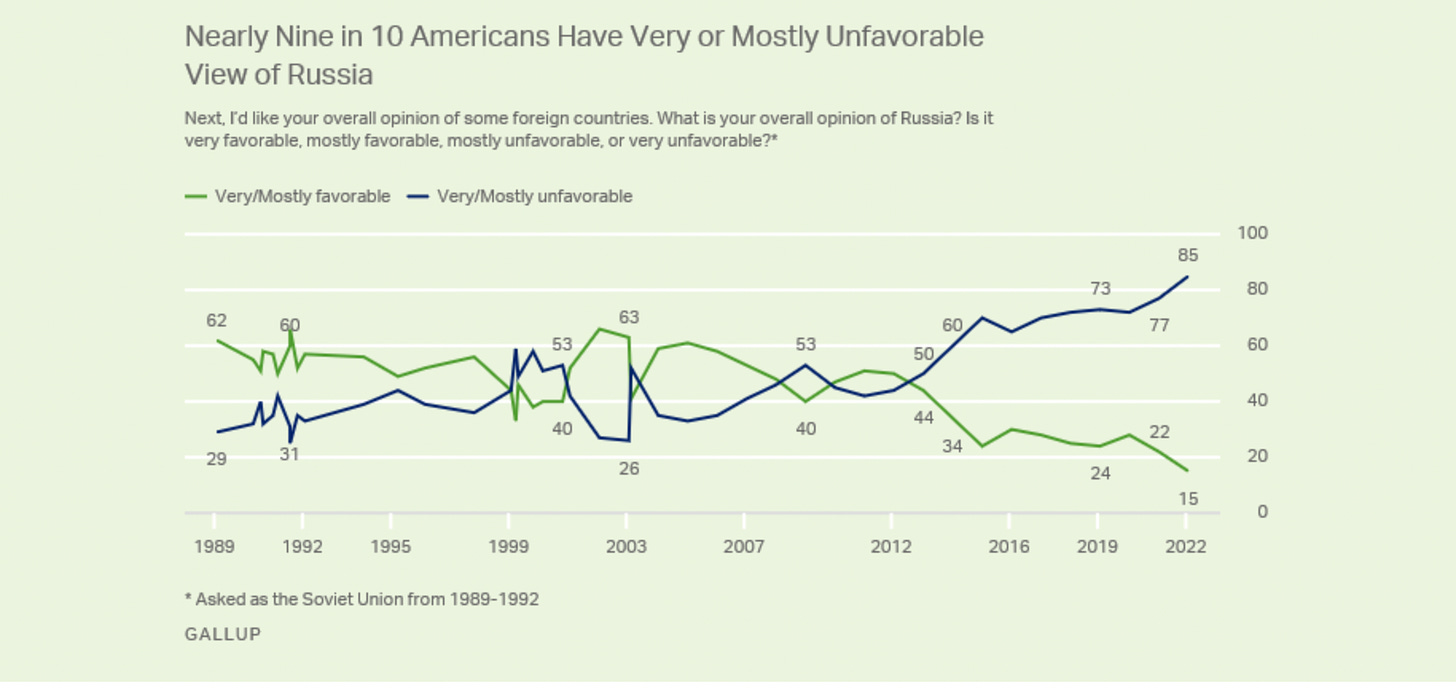
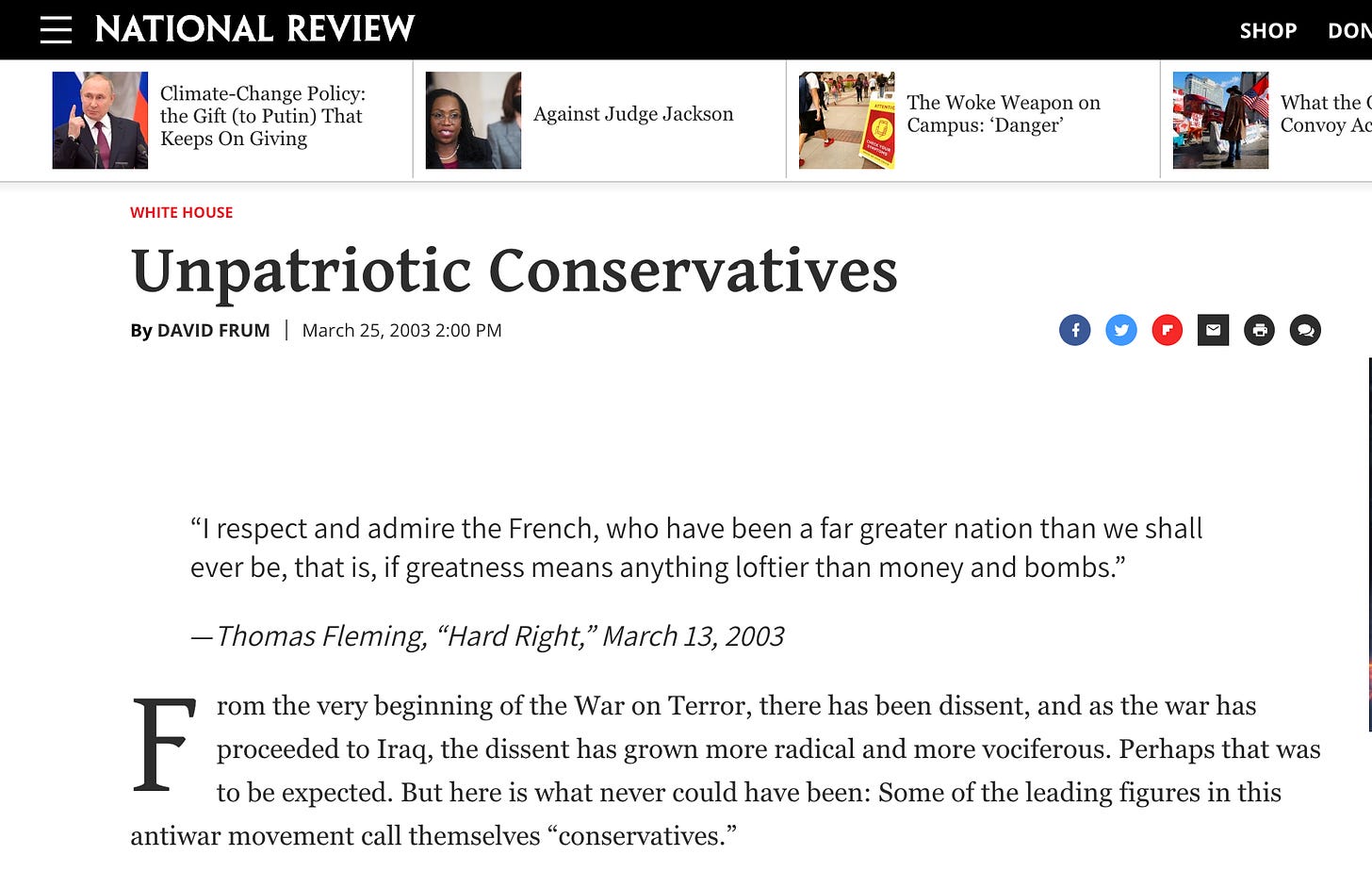

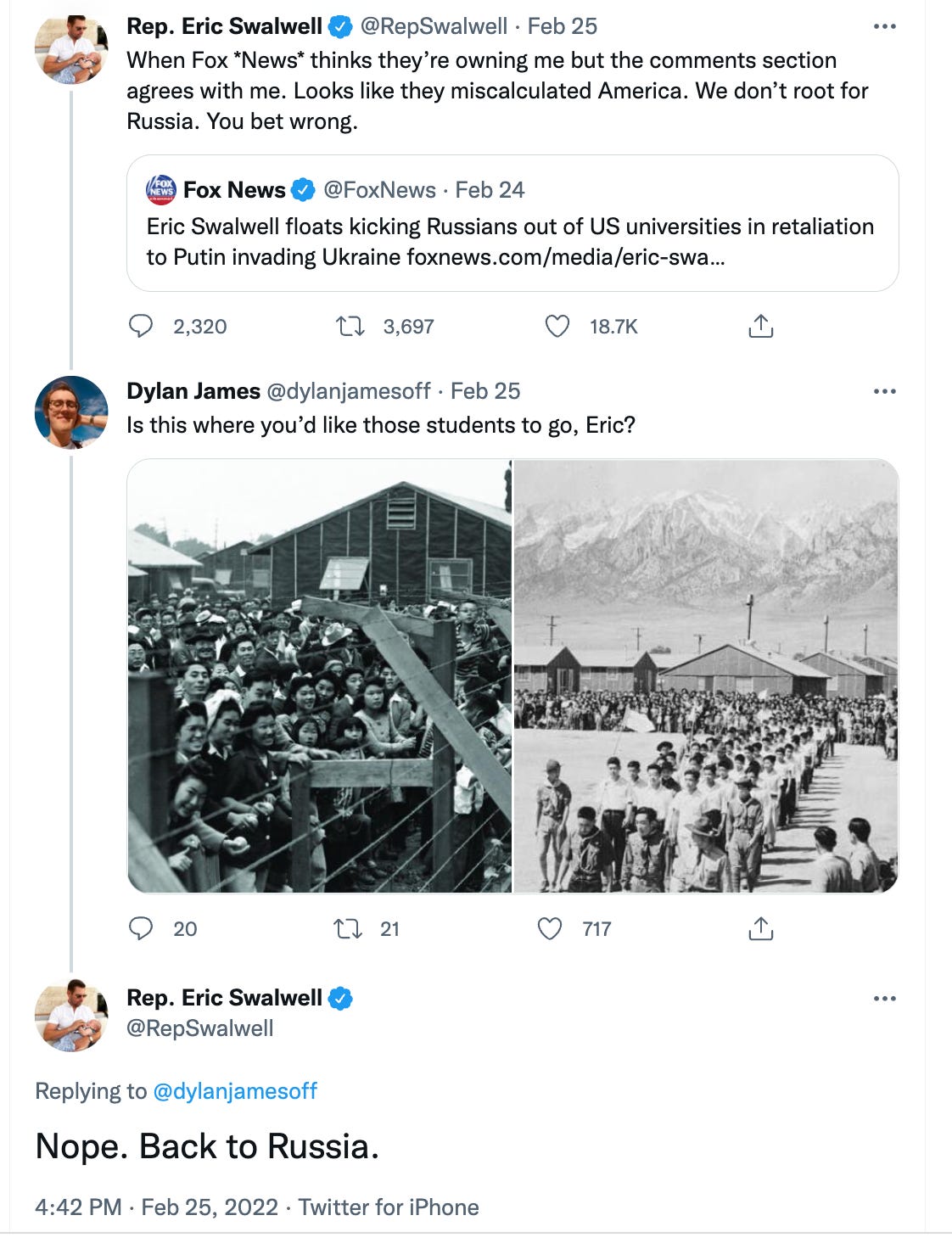
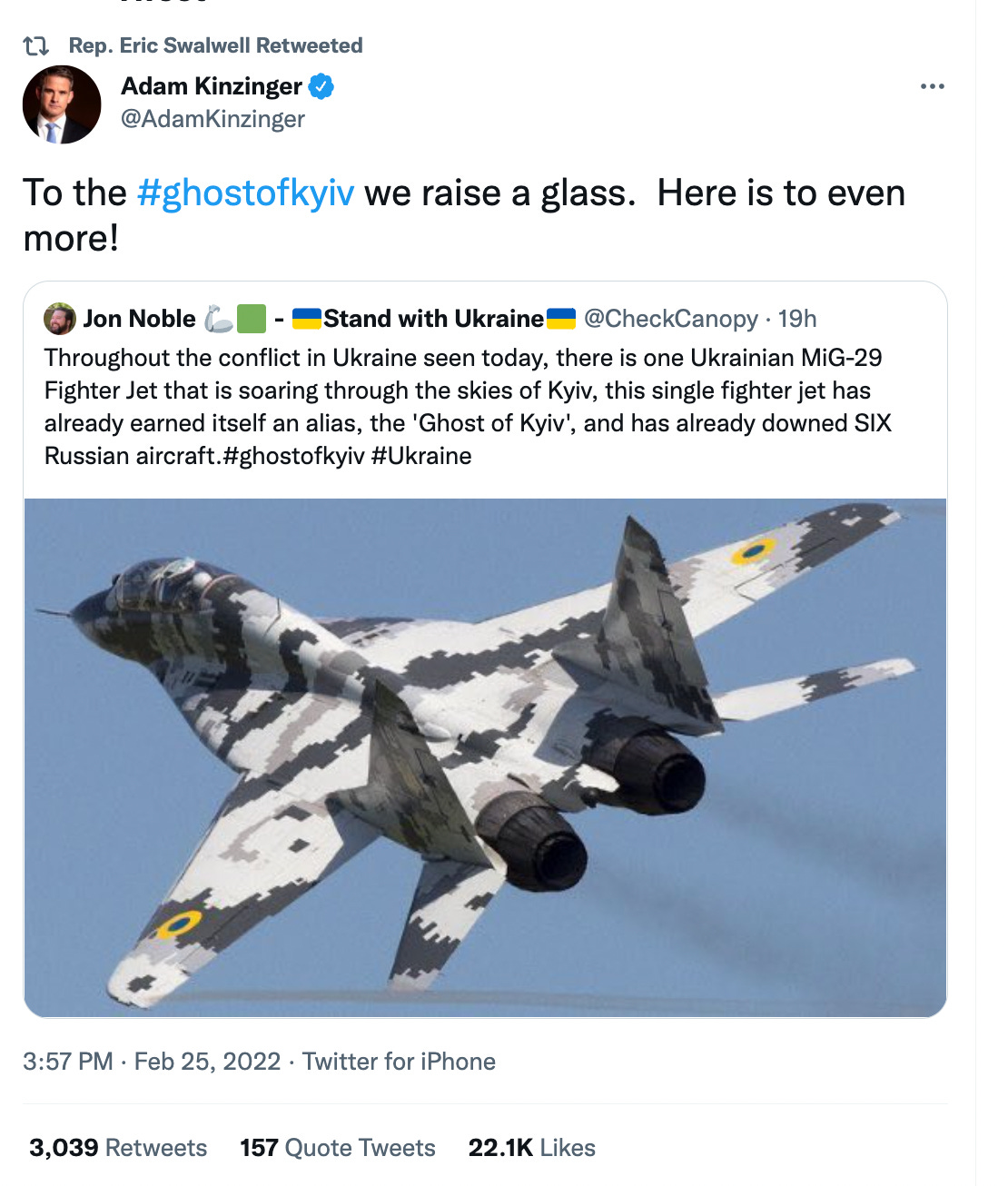
Comments
Post a Comment